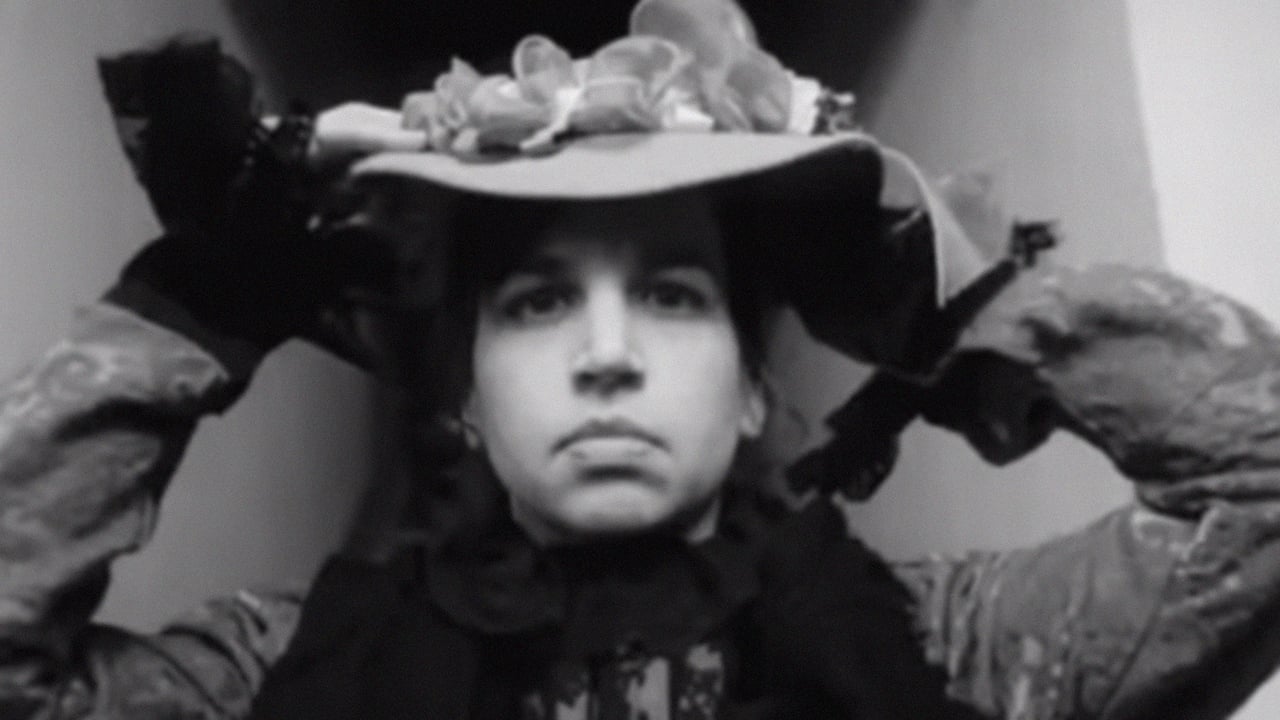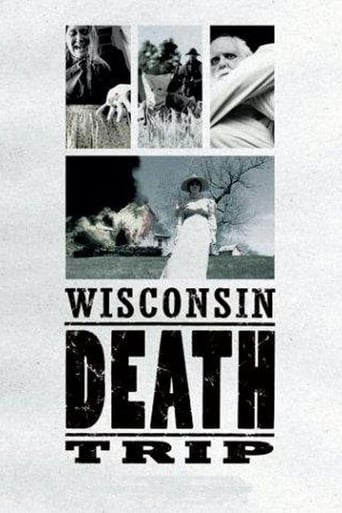

Really Surprised!
... View MoreWhile it doesn't offer any answers, it both thrills and makes you think.
... View MoreGreat story, amazing characters, superb action, enthralling cinematography. Yes, this is something I am glad I spent money on.
... View MoreEach character in this movie — down to the smallest one — is an individual rather than a type, prone to spontaneous changes of mood and sometimes amusing outbursts of pettiness or ill humor.
... View MoreWISCONSIN DEATH TRIP is a one of a kind documentary experience that explores the odd series of violent deaths that plagued a rural Wisconsin town in the late 19th century. The filmmakers do away with the normal structure of a documentary - i.e. an explanatory narrative, talking head interviews and the like - to instead present a montage of reenactments showing these violent deaths in action.So the reader is subjected to an endless barrage of black and white footage of farmers shooting their wives, wives shooting their husbands, suicide, violent behaviour, and people carted off to the asylum. The cinematography is vivid, spooky and atmospheric, bringing to mind German expressionist cinema of the 1920s, but there's little real meat here and virtually no explanation or structure. I wanted to hear more from historians, from psychologists, to explain the bizarre phenomenon but if you're looking for answers, WISCONSIN DEATH TRIP is oddly hollow. Watch it as a visual experience and a celebration of death, nothing more.
... View MoreNot in the traditional documentary format, Wisconsin Death Trip is disturbingly beautiful. The first thing that is noticeable about the film is its intensely visual direction in an extremely eye pleasing black and white art house style backed up with Ian Holm's competent narration (another narrator is used in confusing whisper to tell of those sectioned at the mental asylum, something of which doesn't really make any sense of have any meaning to it but is a nice difference in direction). As a documentary, the film just documents facts. Focusing on strange stories from a small Wisconsin town (Black River City) in the 1890's when (unexplainably) the people started to randomly commit crime after crime in horrific fashion through anarchy, murder, arson, paedophilia and other deranged acts (including a humorous tale of a cocaine addict who persistently smashed local windows for now reason.) Wisconsin Death Trip has these moments of humour, but by no way stretch of the imagination is it a pleasing narrative. Harrowing accounts of acts of violence from the local journalist about the occupiers of the small city and its surroundings are reinacted for the screen in a dry, depressing surrealism. In narrating article after article of random stories of suicide, murder etc the Direction shows actors play out these events in a wonderfully designed time of old in America taking us throughout the seasons of the year in subtly effective montages of newspaper being printed. Contrasted to this is a modern perception of the same town, displaying school children in a playground happily getting on with life. The elderly living contently at a home and other accounts and recollections of stories they had heard from rumour about the history of Black River City and Wisconsin. However, the film never tries to even start to understand what happened in that area for everyone to commit these heinous crimes in the 1890's, nor does it seem to hold this as a relevant part tot the story, it merely documents the events that took place with linear narration and hand in hand visual aids that were very cinematic. It differs greatly to traditional documentaries in this sense by not following any one particular story, but deciding to document what had already happened and disturbingly, this film was made for television, something of which is interesting to contemplate how it was marketed. The film may be looked upon as having no real meaning and would bore audiences who seek an answer, but they would be a hard audience not to be drawn into the film by its wonderful cinematography and appealing narrative.
... View More'Nowhere in this great continent of ours can be found a more desirable residence.' This is a pitch for the small town of Black River Falls, Wisconsin. If by any chance you've already accepted this seemingly ordinarily little exaggeration as the truth, then its time you saw a melancholic little documentary called Wisconsin Death Trip.This is a film which details the events that occurred in Black River Falls during the 1890s and is the director James Marsh's take on the 1970s literary cult classic of the same name, written by Michael Lesy. It seems that the whole town was besieged by fits of suicide, murder, lunacy and several inexplicable and bizarre events that could have been plucked cleanly from an Edward Gory poem. The grim and dark character of this strange little town and its inhabitants are communicated through photographs taken at the time and newspaper reports. The photos are connected to starkly beautiful black and white recreations of the odd goings-on of Black River Falls. Ian Holm narrates the film in a haunting and sometimes blackly comic manner, and a few records from the local insane asylum are whispered disturbingly, telling us about the many inhabitants who were committed there. The recreations are shot with dazzling fluidity, all are stunning to watch and every single one shocks or horrifies to an enthralling degree.Like Aronofsky's Requiem for a Dream, this twisted tale takes place over several seasons and the other-worldly events just keep on happening; from a farmer who blew his own head off with dynamite to a 63 year old-14 year old paedophilliac marriage, they seem never-ending as the depressing Wisconsin Winter looms over the horizon. There are certain characters who keep reappearing throughout the film such as the 13 year old who shot an old man for fun and then participated in a western style chase and gun fight with a posse, and the has-been opera singer, Pauline L'Allemand, who moved to Black River Falls and slowly went mad, hearing voices from the spirit world and ended up in the Mendota Asylum for the Insane.It is the morbid fascination that resides in some of us which makes us want to watch this to the end, to see just how tantalizingly strange the events in this town can get. The macabre style is pulled off with perfection; it is often grisly and melancholic to watch and yet I was fascinated by it and soaked up every moment. Wisconsin Death Trip fails, however in trying to convince us that Black River Falls hasn't changed since the 1890s. Its attempts (in colour, rather than black and white like the rest of the film), are rather forced and unsatisfying. But the blank, placid faces of the old people of the modern day town are certainly reminiscent of the photos taken back at the end of the 19th century. Perhaps the sheer number of the events at the time makes the film a little unbelievable, but it is the photos which remind us that these events actually took place and aid in bringing home the Gothic and demented atmosphere of the whole tragic tale.The truth is: I was horrified and engrossed in the story of this freakish town and the maniacs who resided there. Then, after thinking about it, I realized that the crimes of passion, suicides and gun violence of our so-called 'modern society' were happening over a century ago. I believe that this is one of the most significant points James Marsh was trying to put across.However, there are still some out and out undeniably weird happenings that took place in Black River Falls which would leave us utterly aghast if we saw them in the present day. When viewing, be sure to look out for the Polish girl who set fire to numerous buildings because she was 'lonely and homesick and needed some excitement.' and especially Mary Sweeney, with her window smashing antics.
... View MoreAlthough this is a documentary (taken from a book of the same title that was quite popular in the '70s), it doesn't feel like one. It doesn't feel like a movie either, so I don't know what you'd call it. But one thing I can say is that it is morbidly fascinating. It is narrated by Ian Holmes, the only recognizable name associated with the film, reading news excerpts from a small, northern Wisconsin town's newspaper from the late 1800s. The occurrences are sometimes funny, often tragic, and unsettlingly bizarre. You have to remember that there was a very small population in the area at that time (the area is still not heavily populated), so the number of odd goings-on is curious. These occurrences have even more impact because they are juxtaposed with the very wholesome image that Wisconsin has always possessed (it seems whenever a movie wants to present wholesomeness, they set it in Wisconsin) as well as the beautiful vocabulary and syntax used in written documentation at that time. The documentary is also British, which ads another element to it--somehow I think they find it even more fascinating and that comes through in the presentation. So, Ian Holmes reads the articles and we are shown photos from the period (sometimes they are the real people being discussed, but not always) and re-enactments of the crimes (they are mostly crimes), mishaps, or misfortunes. Infrequently, current-day footage is used, which I have read as a criticism, but which I think is misguided (see below). The strongest thing I came away with from this documentary is that human nature is consistent, no matter what the era. The crimes and occurrences committed in and around this small Wisconsin town in the late 1800s are the same crimes that are being committed everywhere today. There are classic obsession crimes (i.e., a man asked a woman to marry him, she said no, he went to her house and shot her and then himself), classic sociopathic crimes, classic abuse cases, etc. I think the modern-day footage helps to bring this message home. But, there are also some REALLY kooky things too, which are a blast. Look for the teacher who likes to travel by train. . . .See this film if you think the world is going to pot; you'll realise its always been there.
... View More